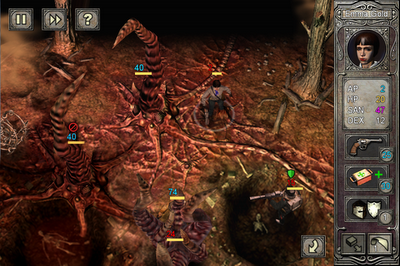Screenshots in this article are copyright © 2011 Red Wasp Design Ltd and are used here for the purpose of review.Games have always been a big part of my life, but for whatever reason, I haven't generally warmed to computer games very often or very much. The last two that I really enjoyed both came out in 1994 —
UFO: Enemy Unknown and
Star Wars: TIE Fighter. These two games also typify the two game genres I like the most: turn-based strategy, and flight simulators. Unfortunately for me, neither of these genres have been in vogue for some time now.
Last week, I was interested to learn that a British indie game studio,
Red Wasp Design had released a game for iOS based on one of my favourite (table-top) role-playing games,
Call of Cthulhu. My love of that game was itself enough reason to give the computer version of it—
Call of Cthulhu: The Wasted Land—a try.
I am very, very glad that I did! Not only was it a credible attempt to bring
Call of Cthulhu to a new medium, but it was turn-based strategy! Hooray!
There are, however, some important differences with the role-playing game. While the actual mechanics seem to be a largely faithful implementation of the RPG mechanics, giving and taking damage are vastly different. Within the group with which I've played
Call of Cthulhu for the last twenty years or so, we have our three golden rules:
- Never split up the party
- Always carry a light
- If it comes to guns, you've done something wrong.
This final point reflects the fact that the supernatural horrors that player characters investigate are routinely invulnerable to normal weapons. It usually takes some kind of magic to defeat these creatures. Conversely, guns are deadly when used on ordinary humans, like the player characters. Getting shot even once can easily put a character out of the story, and even if they survive, healing routinely takes weeks of in-game time.
Call of Cthulhu: The Wasted Land is set in the trenches of World War I. The characters that you control routinely shoot their way from one point in the story to the next, and all the monsters they encounter eventually go down when you pump enough gunfire into them. When the characters take damage, first-aid kits are available to boost them back to maximum hit points immediately. The ubiquity of guns as the solution to all problems is reflected in the unlimited ammunition the characters seem to carry.
 |
| Enemy German soldiers: gun battles are to be expected. |
's signature mechanic—sanity points—are handled similarly. These points represent the mental equivalent of hit points; confront enough horror and characters lose their ability to function, perhaps even becoming permanently insane. Recovering from these mental scars again takes weeks of in-game time. Characters in
Call of Cthulhu: The Wasted Land lose sanity too, but a nearby character with a book on psychotherapy can restore sanity points to maximum in a single turn!
Call of Cthulhu therefore differs from other role-playing games in that in other games, characters gain experience and become stronger, more capable, and more heroic. In
Call of Cthulhu, characters are inexorably driven towards madness, incapacitation, and death. Red Wasp Design evidently decided that this concept doesn't lend itself especially well to computer games, and they're probably right.
 |
| You knew that tentacles had to come into this eventually, right? Guns work fine here too though... |
Call of Cthulhu: The Wasted Land plays very much like
UFO: Enemy Unknown, and I feel quite sure that Red Wasp referred to that earlier game. That said, a few very useful features of its interface are missing and kept me hunting for them! Each character has a certain number of points with which to perform actions during a turn, such as moving or firing a weapon. In
UFO: Enemy Unknown, you can set aside points for combat while moving characters. Without being able to reserve points this way, moving characters while retaining enough points to perform useful actions with them becomes much more tedious. I also missed the ability to make characters kneel down for increased protection from enemy attacks. At the end of your turn in
Call of Cthulhu: The Wasted Land,
characters are frequently left standing around unprotected when no terrain is available to hide in or behind.
All up, however,
Call of Cthulhu: The Wasted Land was a very pleasing and addictive game. It plays out like a highly compressed role-playing campaign in which the monsters are unusually susceptible to lead poisoning :) It also helps that it's gorgeous to look at.
My biggest grievance is that it was only too short! I sincerely hope that Red Wasp will publish further adventures for this game or release other
Call of Cthulhu-based games in future.
Incidentally, "Never split up the party" is sound advice in this game too!

